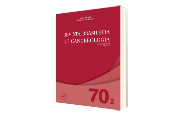Identification of Genes Associated with Testicular Cancer Aggressiveness
DOI:
https://doi.org/10.32635/2176-9745.RBC.2024v70n2.4553Keywords:
Testicular Neoplasms Prognosis, TCGAAbstract
Introduction: Testicular germ cell tumors represent approximately 97% of testicular cancers. Histologically, they are classified into seminomas and non-seminomas, having diagnostic and prognostic applicability. Therapeutic success depends on early diagnosis associated with correct staging, the evaluation of biomarkers is important for the correct management of this disease. Objective: To identify genes that may be correlated with prognosis and survival in testicular cancer. Method: Bioinformatics analysis was performed using 137 testicular cancer samples from The Cancer Genome Atlas and 165 normal testicular tissue samples from The Genotype-Tissue Expression. Gene identification and subsequent analyzes were performed using GEPIA2. Results: Initially, in relation to gene expression, the 500 genes most significantly associated with overall survival from testicular cancer and the 500 with disease-free survival were evaluated. These two lists were then superimposed and a Venn diagram was constructed showing the 13 genes in common. Of these, only the protein-coding genes were kept, investigating which ones differed significantly from normal tissue in relation to gene expression. Only ATP10A, SAMD14 and PCAL4 showed a statistically significant difference, all of which were under-expressed in testicular cancer. The joint analysis of these genes was even more significant for overall and disease-free survival. Conclusion: Three genes were identified in the analysis in silico which demonstrated significative association of the expression with survival and prognosis of patients with testicular cancer.
Downloads
References
Baird DC, Meyers GJ, Hu JS. Testicular cancer: diagnosis and treatment. Am Fam Physician. 2018;97(4):261-8.
Smith ZL, Werntz RP, Eggener SE. Testicular cancer. Med Clin North Am. 2018;102(2):251-64. doi: https://doi.org/10.1016/j.mcna.2017.10.003 DOI: https://doi.org/10.1016/j.mcna.2017.10.003
Teng LK, Pereira BA, Keerthikumar S, et al. Mast Cell-Derived SAMD14 is a novel regulator of the human prostate tumor microenvironment. Cancers. 2021;13(6):1237. doi: https://doi.org/10.3390/cancers13061237 DOI: https://doi.org/10.3390/cancers13061237
Miller KD, Nogueira L, Mariotto AB, et al. Cancer treatment and survivorship statistics, 2019. CA. 2019;69(5):363-85. doi: https://doi.org/10.3322/caac.21565 DOI: https://doi.org/10.3322/caac.21565
Mourão TC, Curado MP, Oliveira RAR, et al. Epidemiology of urological cancers in Brazil: trends in mortality rates over more than two decades. J Epidemiol Glob Health 2022;12(3):239-47. doi: https://doi.org/10.1007/s44197-022-00042-8 DOI: https://doi.org/10.1007/s44197-022-00042-8
Kliesch S, Schmidt S, Wilborn D et al. Management of germ cell tumours of the testis in adult patients. german clinical practice guideline part i: epidemiology, classification, diagnosis, prognosis, fertility preservation, and treatment recommendations for localized stages. Urol Int. 2021;105(3-4):1-12. doi: https://doi.org/10.1159/000510407 DOI: https://doi.org/10.1159/000510407
Yang J, Yang Q. Identification of core genes and screening of potential targets in glioblastoma multiforme by integrated bioinformatic analysis. Front Oncol. 2021;10(615976):1-12. doi: https://doi.org/10.3389/fonc.2020.615976 DOI: https://doi.org/10.3389/fonc.2020.615976
Souza KW, Reis PE, Gomes IP, et al. Estratégias de prevenção para câncer de testículo e pênis: revisão integrativa. Rev Esc Enferm USP. 2011;45(1):277-82. doi: https://doi.org/10.1590/s0080-62342011000100039 DOI: https://doi.org/10.1590/S0080-62342011000100039
Leão R, Ahmad AE, Hamilton RJ. Testicular cancer biomarkers: a role for precision medicine in testicular cancer. Clin Genitourin Cancer. 2019;17(1):e176-83. doi: https://doi.org/10.1016/j.clgc.2018.10.007 DOI: https://doi.org/10.1016/j.clgc.2018.10.007
Nacional Cancer Institute, Center for Cancer Genomics [Internet]. Annapolis: NIH; 2006. The Cancer Genome Atlas (TCGA); 2006. [acesso 2024 mar 8]. Disponível em: https://www.cancer.gov/ccg/research/genome-sequencing/tcga
GTEx: The Genotype-Tissue Expression [Internet]. Versão phs000424.v9.p2. Bethesda: NIH; [sem data]. [acesso 2024 mar 8]. Disponível em: https://gtexportal.org/home/
Conselho Nacional de Saúde (BR). Resolução n° 510, de 7 de abril de 2016. Dispõe sobre as normas aplicáveis a pesquisas em Ciências Humanas e Sociais cujos procedimentos metodológicos envolvam a utilização de dados diretamente obtidos com os participantes ou de informações identificáveis ou que possam acarretar riscos maiores do que os existentes na vida cotidiana, na forma definida nesta Resolução [Internet]. Diário Oficial da União, Brasília, DF. 2016 maio 24 [acesso 2024 jan 20]; Seção I:44. Disponível em: http://bvsms.saude.gov.br/bvs/saudelegis/cns/2016/res0510_07_04_2016.html
Tang Z, Kang B, Li C, et al. GEPIA2: an enhanced web server for large-scale expression profiling and interactive analysis. Nucleic Acids Res. 2019;47(W1):W556-60. doi: https://doi.org/10.1093/nar/gkz430 DOI: https://doi.org/10.1093/nar/gkz430
Chandrashekar DS, Karthikeyan SK, Korla PK, et al. UALCAN: uma atualização para a plataforma integrada de análise de dados de câncer. Neoplasia. 2022;25:18-27. doi: https://doi.org/10.1016/j.neo.2022.01.001 DOI: https://doi.org/10.1016/j.neo.2022.01.001
Bruijn I, Kundra R, Mastrogiacomo B, et al. Analysis and visualization of longitudinal genomic and clinical data from the AACR project GENIE Biopharma Collaborative in cBioPortal. Cancer Res. 2023;83(23):3861-7. doi: https://doi.org/10.1158/0008-5472.can-23-0816 DOI: https://doi.org/10.1158/0008-5472.CAN-23-0816
WebGestalt [Internet]. Versão 1.2. Houston: Zhang Lab; ©2024. [acesso 2024 mar 8]. Disponível em: http://webgestalt.org/
Toni L, Šabovic I, Cosci I, et al. Testicular cancer: genes, environment, hormones. Front Endocrinol. 2019;10(408):1-11. doi: https://doi.org/10.3389/fendo.2019.00408 DOI: https://doi.org/10.3389/fendo.2019.00408
Boccellino M, Vanacore D, Zappavigna S, et al. Testicular cancer from diagnosis to epigenetic factors. Oncotarget. 2017;8(61):104654-63. doi: https://doi.org/10.18632/oncotarget.20992 DOI: https://doi.org/10.18632/oncotarget.20992
Chieffi P, Franco R, Portella G. Molecular and cell biology of testicular germ cell tumors. Int Rev Cell Mol Biol. 2009;278:277-308. doi: https://doi.org/10.1016/s1937-6448(09)78006-2 DOI: https://doi.org/10.1016/S1937-6448(09)78006-2
Murray MJ, Huddart RA, Coleman N. The present and future of serum diagnostic tests for testicular germ cell tumours. Nat Rev Urol. 2016;13(12):715-25. doi: https://doi.org/10.1038/nrurol.2016.170 DOI: https://doi.org/10.1038/nrurol.2016.170
Nauman M, Leslie SW. Nonseminomatous testicular tumors. In: StatPearls [Internet]. Treasure Island: StatPearls Publishing; 2023. [acesso 2024 mar 8]. Disponível em: https://www.ncbi.nlm.nih.gov/books/NBK568754/
Baylin SB, Jones PA. A decade of exploring the cancer epigenome — biological and translational implications. Nat Rev Cancer. 2011;11(10):726-34. doi: https://doi.org/10.1038/nrc3130 DOI: https://doi.org/10.1038/nrc3130
Chung CC, Kanetsky PA, Wang Z, et al. Meta-analysis identifies four new loci associated with testicular germ cell tumor. Nat Genet. 2013;45(6):680-5. doi: https://doi.org/10.1038/ng.2634 DOI: https://doi.org/10.1038/ng.2634
Xu X, Chang X, Xu Y, et al. SAMD14 promoter methylation is strongly associated with gene expression and poor prognosis in gastric cancer. Int J Clin Oncol. 2020;25(6):1105-14. doi: https://doi.org/10.1007/s10147-020-01647-4 DOI: https://doi.org/10.1007/s10147-020-01647-4
Published
How to Cite
Issue
Section
License
Os direitos morais e intelectuais dos artigos pertencem aos respectivos autores, que concedem à RBC o direito de publicação.

This work is licensed under a Creative Commons Attribution 4.0 International License.









